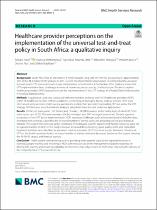| dc.identifier.citation | Nicol, E., Mehlomakulu, V., Jama, N. A., Hlongwa, M., Basera, W., Pass, D., & Bradshaw, D. (2023). Healthcare provider perceptions on the implementation of the universal test-and-treat policy in south africa: A qualitative inquiry. BMC Health Services Research, 23(1) doi:10.1186/s12913-023-09281-2 | en_US |
| dc.description.abstract | Background South Africa had an estimated 7.5 million people living with HIV (PLHIV), accounting for approximately
20% of the 38.4 million PLHIV globally in 2021. In 2015, the World Health Organization recommended the universal
test and treat (UTT) intervention which was implemented in South Africa in September 2016. Evidence shows that
UTT implementation faces challenges in terms of human resources capacity or infrastructure. We aim to explore
healthcare providers (HCPs)’ perspectives on the implementation of the UTT strategy in uThukela District Municipality
in KwaZulu-Natal province.
Methods A qualitative study was conducted with one hundred and sixty-one (161) healthcare providers (HCPs)
within 18 healthcare facilities in three subdistricts, comprising of Managers, Nurses, and Lay workers. HCPs were
interviewed using an open ended-survey questions to explore their perceptions providing HIV care under the UTT
strategy. All interviews were thematically analysed using both inductive and deductive approaches.
Results Of the 161 participants (142 female and 19 male), 158 (98%) worked at the facility level, of which 82 (51%)
were nurses, and 20 (12.5%) were managers (facility managers and PHC manager/supervisors). Despite a general
acceptance of the UTT policy implementation, HCPs expressed challenges such as increased patient defaulter rates,
increased work overload, caused by the increased number of service users, and physiological and psychological
impacts. The surge in the workload under conditions of inadequate systems’ capacity and human resources, gave rise
to a greater burden on HCPs in this study. However, increased life expectancy, good quality of life, and immediate
treatment initiation were identified as perceived positive outcomes of UTT on service users. Perceived influence of
UTT on the health system included, increased number of patients initiated, decreased burden on the system, meeting
the 90-90-90 targets, and financial aspects.
Conclusion Health system strengthening such as providing more systems’ capacity for expected increase in
workload, proper training and retraining of HCPs with new policies in the management of patient readiness for
lifelong ART journey, and ensuring availability of medicines, may reduce strain on HCPs, thus improving the delivery of
the comprehensive UTT services to PLHI | en_US |

